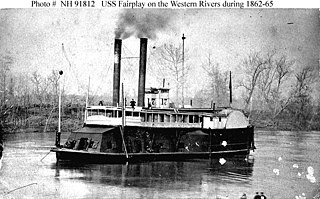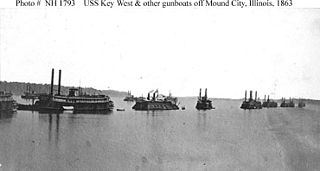The first USS Arizona was an iron-hulled, side-wheel merchant steamship. Seized by the Confederate States of America in 1862 during the American Civil War, she was captured later the same year by the United States Navy.

The third USS Lexington was a timberclad gunboat in the United States Navy during the American Civil War.

The first USS Miami was a side-wheel steamer, double-ender gunboat in the United States Navy during the American Civil War.
The Battle of Johnsonville was fought November 4–5, 1864, in Benton County, Tennessee and Humphreys County, Tennessee, during the American Civil War. Confederate cavalry commander Major General Nathan Bedford Forrest culminated a 23-day raid through western Tennessee by attacking the Union supply base at Johnsonville. Forrest's attack destroyed numerous boats in the Tennessee River and millions of dollars of supplies, disrupting the logistical operations of Union Major General George H. Thomas in Nashville. As a result, Thomas's army was hampered in its plan to defeat Confederate Lieutenant General John Bell Hood's invasion of Tennessee, the Franklin-Nashville Campaign.

Fairplay was a wooden riverine ship in the United States Navy during the American Civil War.
The second Navy vessel to bear the name Sachem, this screw steamer was built in 1844 at New York City, where it was purchased by the Navy on 20 September 1861.

USS Clifton was a shallow-draft side-wheel paddle steamer, built in 1861 at Brooklyn, as a civilian ferry. The Union Navy bought her early that December, and commissioned her after having her converted into a gunboat. In 1863 she ran aground, was captured and commissioned into the Texas Marine Department. Her career ended in 1864 when she ran aground and her Confederate crew burned her to prevent her recapture.

USS Calhoun was a captured Confederate steamer and blockade runner acquired by the Union Navy from the prize court during the American Civil War.

USS Linden (1860) was a steamer acquired by the Union Navy during the American Civil War. She was used by the Navy to patrol navigable waterways of the Confederacy to prevent the South from trading with other countries.

USS Cricket (1862) was a steamer acquired by the Union Navy during the American Civil War.
USS Moose (1863) was a steamer purchased by the Union Navy during the American Civil War. She was used by the Union Navy as a gunboat assigned to patrol Confederate waterways to prevent the South from trading with other countries.
USS Fairy (1861) was a steamer purchased by the Union Navy during the American Civil War.
USS Victory (1863) was a steamer purchased by the Union Navy during the American Civil War.

USS Silver Lake (1862) was a steamer purchased by the Union Navy during the American Civil War.
USS Hastings (1860) was a steamer purchased by the Union Navy during the American Civil War. She was used by the Union Navy as a gunboat assigned to patrol Confederate waterways.

USS Eastport was a steamer captured by the Union Navy during the American Civil War. She was used by the Union Navy as a convoy and patrol vessel on Confederate waterways.
USS Tawah (1863) was a 108-ton steamer acquired by the Union Navy during the American Civil War.

USS Key West (1862) was a steamer acquired by the Union Navy during the American Civil War. She was used by the Union Navy as a convoy and patrol vessel on Confederate waterways, only to be sunk, along with Elfin and Tawah by Confederate shore batteries.
USS Exchange (1862) was a steamer acquired by the Union Navy during the American Civil War.
USS Sallie Wood (1860) was a 256-ton steamer captured by the Union Navy during the early years of the American Civil War.









